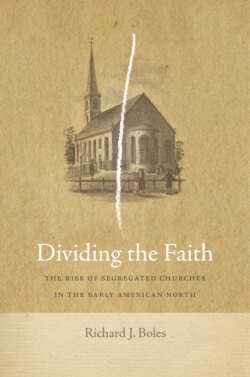Dividing the Faith

Реклама. ООО «ЛитРес», ИНН: 7719571260.
Оглавление
Richard J. Boles. Dividing the Faith
DIVIDING THE FAITH. The Rise of Segregated Churches in the Early American North
CONTENTS
FIGURES AND TABLES. Figures
Tables
Introduction
1 / “Not of Whites Alone, but of Blacks Also”: Black, Indian, and European Protestants, 1730–1749
Understanding Black and Indian Beliefs and Motivations
Interracial Churches of New England
Mid-Atlantic Anglicans, Lutherans, and Moravians
2 / “I Claim Jesus Christ to Be My Right Master”: Black-White Religious Conflicts and Indian Separatists, 1740–1763
Black and Indian Participation Levels, 1750–1763
The Rise and Limits of Separate Indian Churches
Conflicts between Blacks and Whites in Churches
3 / “Compassion upon These Outcasts”: Evangelism and Expanding Interracial Worship, 1764–1776
Early Methodist Church Affiliation
Baptist Church Affiliation
Congregational Churches
Anglican Church Affiliation
Indian Church Affiliation, 1764 to 1790
4 / “Slavery Is a Bitter Pill”: Interracial Churches, War, and Abolitionism, 1776–1790
New England Churches
Mid-Atlantic Churches
5 / “To Restore Our Long Lost Race”: The Rise of Separate Black Churches, 1791–1820
The Rise of Separate Black Churches
Blacks and Indians within Predominantly White Churches
Changing Notions of Race and Christian Equality
6 / “Suffering under the Rod of Despotic Pharaohs”: The Segregated North and Black and Indian Christian Radicalism, 1821–1850
Black Participation in Predominantly White Churches
Church Integrationists
Black and Indian Radical Christian Critiques
Conclusion
Acknowledgments
Abbreviations
Note on Sources
Notes. Introduction
1 / “Not of Whites Alone, but of Blacks Also”
2 / “I Claim Jesus Christ to Be My Right Master”
3 / “Compassion upon These Outcasts”
4 / “Slavery Is a Bitter Pill”
5 / “To Restore Our Long Lost Race”
6 / “Suffering under the Rod of Despotic Pharaohs”
Conclusion
Index
About the Author
Отрывок из книги
Early American Places is a collaborative project of the University of Georgia Press, New York University Press, Northern Illinois University Press, and the University of Nebraska Press. The series is supported by the Andrew W. Mellon Foundation. For more information, please visit www.earlyamericanplaces.com.
ADVISORY BOARD
.....
Boston, the largest town in colonial New England and home to Massachusetts’s largest concentration of enslaved blacks, was a center for interracial religious activity. In the 1740s, Boston’s population was somewhere between 7 and 15 percent black. All of Boston’s oldest nine Congregational churches and three Anglican churches baptized black people during the 1730s and 1740s, as indicated in table 1.1. In some of these churches, a small number of Indians were also baptized. Most of the Congregational churches admitted some black people to full membership too. However, there were noteworthy differences in the levels of black participation in these churches.43 The diversity of Congregational churches in this one location makes Boston a useful example for analyzing black church affiliation in New England.
Boston Congregational churches connected to the Great Awakening’s revivalism baptized many black people, but some blacks were also baptized in the Congregational and Anglican churches that did not promote the revival. In other words, some of the revival-focused Congregational churches did more to recruit members than the other Congregational churches by actively seeking out black congregants, but black people still joined churches whose pastors did not do so. Black people did not always come to churches in search of emotional or enthusiastic revivalism.44 What seems to have attracted many black people to predominantly white churches was the personal influence of pastors who were active in parish visitations and catechisms. The Congregational churches that showed the most vitality and baptized and admitted the most people were those whose minister not only embraced revival techniques associated with Whitefield but also frequently visited and catechized their congregants.45
.....